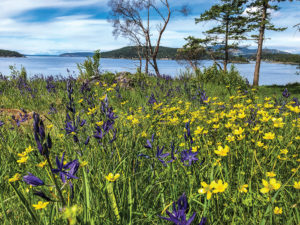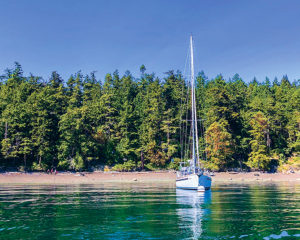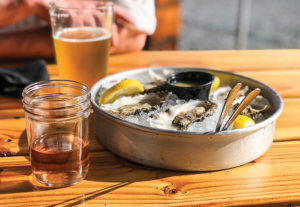We pulled into Rosario Resort on a gloriously warm Thursday afternoon and saw something we hadn’t expected to see — an almost empty marina.
I walked up the dock as a group of geese and goslings swam in the shallow water beside it, stillness hanging in the air. This was Rosario as we’d never experienced it before, tranquil and fragrant, the promise of summer just around the corner.
 We’d encounter similar scenes over the two weeks in early May we spent poking around the San Juan Islands. Everywhere we went, there were empty mooring balls, dock space at state parks, near-deserted hiking trails, and wildflowers in bloom.
We’d encounter similar scenes over the two weeks in early May we spent poking around the San Juan Islands. Everywhere we went, there were empty mooring balls, dock space at state parks, near-deserted hiking trails, and wildflowers in bloom.
Like many Pacific Northwest boaters, we typically head up to the islands during summer. In pre-covid times, Marty often traveled for work and was too busy in winter and spring to take vacation. And every winter there was some boat project that invariably stretched out right to the start of boating season, part of the (nine years and counting and finally almost done) refit of our 1984 Passport 40, Rounder.
But last year we wrapped up a major hull project in the fall, sold our home in Seattle, and moved onto the boat in late February. We planned to start another boat project in May and found ourselves, gloriously, with time on our hands. We were both working remotely and there was nowhere we needed to be until we moved into our new house in July. So we headed up to the islands.
Our first stop was Friday Harbor, where docking typically involves a fun game of dodge-and-weave to avoid the boats coming and going in various directions. Not this time. We motored relatively stress-free into our assigned slip, the nearest boat a few slips away. The normally busy customs dock was empty, the marina uncharacteristically quiet.
The following morning, I was sitting in the cockpit drinking coffee and reading when the stillness was broken by a whoosh nearby. I looked up to see what looked like a dolphin (or maybe it was a porpoise) surface inside the marina, zooming across the water for a few seconds before diving back under.
On Monday, weekend tourists emptied out and the town slipped back into sleepy mode. The day was overcast and chilly, a low mist hanging over nearby Brown Island. After finishing up with work, Marty and I walked over to Cease & Desist, a curiously named beer joint (yes, there’s a story behind that) with a great selection of rotating taps overlooking the harbor. As I sipped a passionfruit and coconut ale that tasted deliciously like a mimosa, we watched ferries arriving, feeling more like locals than transient boaters.
 The next day we popped over to Jones Island at lunch and miraculously snagged a spot at the state park dock — a bit of luck that would be nearly impossible in the summer, when even getting a mooring ball is difficult. On breaks from work, we walked the two trails looping around the island, past stands of madronas and clusters of brittle prickly pear cactus.
The next day we popped over to Jones Island at lunch and miraculously snagged a spot at the state park dock — a bit of luck that would be nearly impossible in the summer, when even getting a mooring ball is difficult. On breaks from work, we walked the two trails looping around the island, past stands of madronas and clusters of brittle prickly pear cactus.
The island’s two dozen campsites, many with breathtaking water views, were empty. We saw only two people on the trails. As the sun set, we sat in our cockpit feeling absurdly lucky, as we have many times during the past year, to be able to work from and experience such a spectacular place.
From Jones we headed to Orcas to meet up with friends who recently bought a home there. Since they had a car, we were able to see more of the island than on previous visits and got a new appreciation for how much there is to see and do there. And eat. Boy, did we eat.
We had dinner at Matia Kitchen & Bar in Eastsound, which had just opened four days prior. It was the first time any of us had eaten inside a restaurant since the start of the pandemic, and the meal turned out to be celebratory and unexpectedly special. Everything we ordered, from pan-roasted halibut to steak tartare, was thoughtfully prepared, perfectly cooked, and off-the-chart delicious.
After a 6-mile hike up Turtleback Mountain on Mother’s Day, we headed hungrily to Buck Bay Shellfish Farm’s outdoor bistro and wine bar, which has picnic tables overlooking the bay and a fish market in a rustic old building. The vibe is low-key, the setting stunning. Over bottles of rosé, we dug into crab mac-and-cheese, halibut sliders, oysters and crab cakes — all of which I would happily eat again.
 We liked the place so much that we decided to go to Obstruction Pass State Park, on the southeast end of East Sound, the following weekend so we could dinghy the mile or so to the county dock in the hamlet of Olga and make the short walk back to Buck Bay to try more of their delectable fare. It was another warm, sunny day, yet all three of the mooring balls in the anchorage were empty.
We liked the place so much that we decided to go to Obstruction Pass State Park, on the southeast end of East Sound, the following weekend so we could dinghy the mile or so to the county dock in the hamlet of Olga and make the short walk back to Buck Bay to try more of their delectable fare. It was another warm, sunny day, yet all three of the mooring balls in the anchorage were empty.
One afternoon we took Rounder over to Yellow Island, about four miles from where we were moored in West Sound. A Nature Conservancy preserve since 1979, the island is known for its springtime wildflower displays. Dinghying ashore, we were met with a riotous display of red, purple, orange and yellow blooms. A tour group of kayakers onshore soon left and we spent the next few hours with our friends watching birds, walking the island’s trail, wandering the beach and picking up pieces of sea glass. We headed back to Orcas filled with the day’s magic, happy and grateful.
After saying goodbye to our friends, we headed to Rosario for a few nights. The store and restaurant overlooking the marina wasn’t yet open for the season, and the usual summer sounds of kids splashing in the outdoor pool were noticeably absent. We walked up the road to Moran State Park and along the trail looping around Cascade Lake, passing empty campsites along the way, then paddled on rented boards around the placid lake.
We capped off the day with a trip to the indoor pool and whirlpool in Rosario’s spa, tucked into the bottom level of the historic Moran Mansion. Reservations are required because of covid guidelines, and since we had the only one at our allotted time, we had the place to ourselves. We swam lazy laps, enjoying views of Cascade Bay and forested mountains, then soaked in the whirlpool. After living on the boat for months, a soak felt like a decadent treat, especially for just $12 each (the cost of a spa pass for marina guests).
We tore ourselves away from the islands after a couple of weeks, only because we had plans to meet up with our boat repair guru in Anacortes for a project. We’re already talking about a San Juans/Gulf islands trip next year (or sooner), and it won’t be in summer if we can help it. The weather might be better then, though we lucked out with sunny skies and warm temperatures most of the time.
But experiencing the San Juans without the crowds made a region we’ve visited many times feel both familiar and wonderfully new. If it’s possible for us to fall in love with this spectacular corner of the world even a little more, we did.






